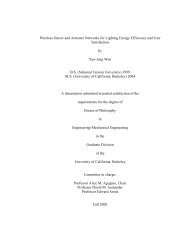Feature dimensionality reduction for partial - Berkeley Expert ...
Feature dimensionality reduction for partial - Berkeley Expert ...
Feature dimensionality reduction for partial - Berkeley Expert ...
Create successful ePaper yourself
Turn your PDF publications into a flip-book with our unique Google optimized e-Paper software.
with different PD sources, thus can be used as features <strong>for</strong> PD identification orclassification.C) <strong>Feature</strong>s from “classification map”. PD pulses are different in wave shape dependingon the location and nature of the underlying defect that generates PD. One way to capture2the different wave shapes is to use so-called “equivalent time-length”, T , and2“equivalent bandwidth”, W [Contin et al (2000)].2 2In the T − W plane (also called the “classification map” by [Contin et al (2000)]), eachPD pulse is presented as a point and each sequence of PD pulses, which are similar in2 2shape, fall into a well-defined area (cluster) in the T − W plane. The location and shape2 2of the clusters in the T − W plane differ corresponding to different PD sources [Continet al (2000 & 2002)]. In this paper, characteristics of the clusters are extracted throughstatistical analysis and used as features <strong>for</strong> classification purpose. The features extracted22include overall mean, means and standard deviations in both T and W directions,respectively, 1 st through 4 th 22orders of moments of distributions in both T and Wdirections, respectively, direction of the 1 st eigenvector of the cluster, and ratio of the firsttwo eigenvalues of the cluster.D) <strong>Feature</strong>s from spectrum analysis. Frequency spectrum of a PD pulse indicatesfrequency components of the PD pulse. Thus the shape or distribution of frequencyspectra should be correlated with different PD sources. In this paper, the first 3frequencies corresponding to the highest three magnitudes, the three highest magnitudesthemselves, the difference between the three frequencies, and the difference between thethree magnitudes are used as features.E) <strong>Feature</strong>s from raw PD signals. They are the maximum and minimum peaks of PDpulses, mean and standard deviation of peaks of PD pulses, inception voltage, and PDrate.The five feature extraction methods yield 86 features in total. Including the temperatureand humidity measurements, we have 88 features <strong>for</strong> each of the 596 data samples, whichwe can use <strong>for</strong> feature trans<strong>for</strong>mation study.4. Classification results: PD diagnosis is a classification problem where the extractedfeatures from PD measurements are the inputs and the sources of PD or condition statusof the wire monitored are the class targets. There are a great number of classifiersavailable, ranging from traditional statistical methods to more modern methods (such asneural network classifiers and support vector machines (SVMs)). To study theeffectiveness of feature trans<strong>for</strong>mation on improving classification per<strong>for</strong>mance of PDdiagnostic systems, in this paper, we use support vector machines as the classifier <strong>for</strong>diagnosing aircraft wiring faults. SVMs are a recently developed learning systemoriginated from the statistical learning theory [Vapnik (1995)]. One distinction betweenSVMs and many other learning systems is that its decision surface is an optimalhyperplane in a high dimensional feature space. The optimal hyperplane ismathematically found by solving a properly <strong>for</strong>med convex quadratic problem with
















